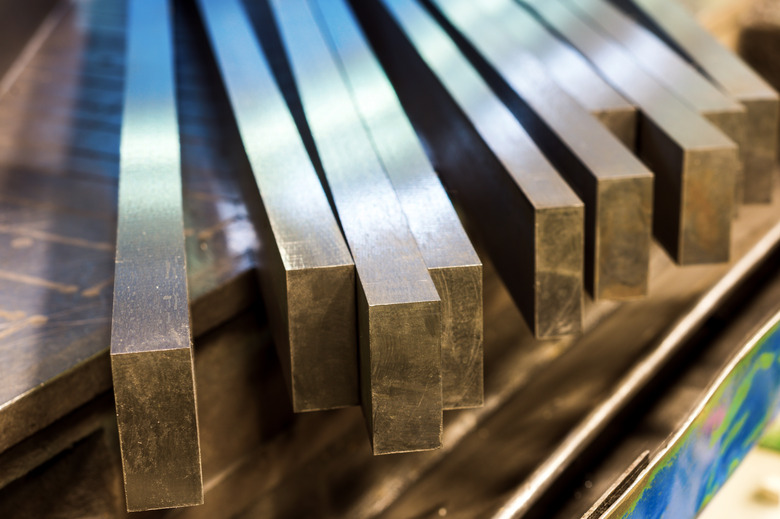What Are The Top 10 Strongest Metals On Earth?
It's useful for scientists and engineers to group metals from strongest to weakest, but the main obstacle to doing this meaningfully is that strength is defined by several properties. Keeping this in mind, steel and its alloys usually top most lists for general strength. Tungsten is generally number one on lists that are restricted to natural metals, although titanium is a close contender. None of these metals are as hard as diamond or as tough as graphene, but these carbon lattice structures are not metals.
Four Strength Determinants
Four Strength Determinants
When evaluating the strength of a metal, you could be talking about any one of four qualities:
- Tensile strength is a measure of how well a metal resists being pulled apart. Cookie dough and silly putty both have low tensile strength, whereas graphene has one of the highest tensile strengths ever recorded.
- Compressive strength or hardness measures how well a material resists being squeezed together. One way to determine this is to use the Mohs scale, with values from 0 to 10, with 10 being the hardest.
- Yield strength refers to how well a rod or beam of a particular metal resists bending and permanent deformation. This is an important measure for structural engineers.
- Impact strength is the ability of a material to resist impact without shattering. Although diamond scores 10 ion the Moh's scale, it can shatter if struck by a hammer. Steel isn't as hard as diamond, but you can't shatter it easily.
Alloys Vs. Natural Metals
Alloys Vs. Natural Metals
Alloys are combinations of metals, and the main reason for making alloys is to produce a stronger material. The most important alloy is steel, which is a combination of iron and carbon and is much harder than either of its two elemental components. Metallurgists create alloys of most metals, even steel, and they belong on lists of the hardest metals.
A List of the Strongest Metals
A List of the Strongest Metals
Because so many factors combine to define the strength of a metal, it's difficult to arrange an ordered list from strongest to weakest. The following unordered list includes the world's strongest natural metals and alloys, but the order would change depending on which property is considered most important.
Carbon Steel – This common alloy of iron and carbon has been in production for centuries and scores highly for all four qualities that define strength. It has a yield strength of 260 mega pascals (Mpa) and a tensile strength of 580 Mpa. It scores about 6.0 on the Mohs scale and is highly impact resistant.
Steel-Iron-Nickel Alloy – There are a few variations of this alloy, but in general, alloying carbon steel with nickel increases the yield strength to as much as 1,420 MPa and the tensile strength to as much as 1,460 Mpa.
**Stainless Steel –** An alloy of steel, chromium and manganese produces a corrosion-resistant metal with yield strength of up to 1,560 Mpa and a tensile strength of up to 1,600 Mpa. Like all types of steel, this alloy is highly impact resistant and scores mid-range on the Mohs scale.
Tungsten – With the highest tensile strength of any naturally occurring metal, tungsten is often combined with steel and other metals to create even stronger alloys. Tungsten is brittle, however, and shatters under impact.
Tungsten carbide – An alloy of tungsten and carbon, this material is commonly used for tools with cutting edges, such as knives, circular saw blades and drill bits. Tungsten and its alloys have typical yield strengths from 300 to 1,000 Mpa and tensile strengths from 500 to 1,050 Mpa.
Titanium – This naturally occurring metal has the highest tensile strength to density ratio of any metal, which makes it, pound-for-pound, stronger than tungsten. It scores lower on the Mohs scale of hardness, though. Titanium alloys are strong and lightweight and are often used in the aerospace industry.
Titanium aluminide – This alloy of titanium, aluminum and vanadium, has a yield strength of 800 Mpa and a tensile strength of 880 Mpa.
Inconel – A superalloy of austenite, nickel and chromium, inconel retains its strengths in extreme conditions and high temperatures, making it suitable for high-speed turbines and nuclear reactor applications.
**Chromium –** If you define a metal's strength simply on the basis of how hard it is, then chromium, which scores 9.0 on the Mohs scale, would top your list. By itself, it isn't as strong as other metals in terms of yield and tensile strength, but it is often added to alloys to make them harder.
**Iron –** One of the components of steel, and the go-to metal for tool and weapon makers throughout the ages, iron completes the list of the world's strongest metals. Cast iron scores about 5 on the Mohs scale, and its yield and tensile strengths are about 246 and 414 Mpa respectively.
References
- Power Injection Moulding International: Table of Tensile Properties of Representative MIM Alloys
- Engineers Edge: Yield Strength
- Gizmodo: Giz Explains: What's the Strongest Material Known to Man?
- The Metals Supermarket: The Strongest Metals
- Dadong Fuding Engineering Machinery Co., Ltd.: Cast Iron Mechanical Properties
Cite This Article
MLA
Deziel, Chris. "What Are The Top 10 Strongest Metals On Earth?" sciencing.com, https://www.sciencing.com/top-10-strongest-metals-earth-2595/. 13 March 2018.
APA
Deziel, Chris. (2018, March 13). What Are The Top 10 Strongest Metals On Earth?. sciencing.com. Retrieved from https://www.sciencing.com/top-10-strongest-metals-earth-2595/
Chicago
Deziel, Chris. What Are The Top 10 Strongest Metals On Earth? last modified March 24, 2022. https://www.sciencing.com/top-10-strongest-metals-earth-2595/
